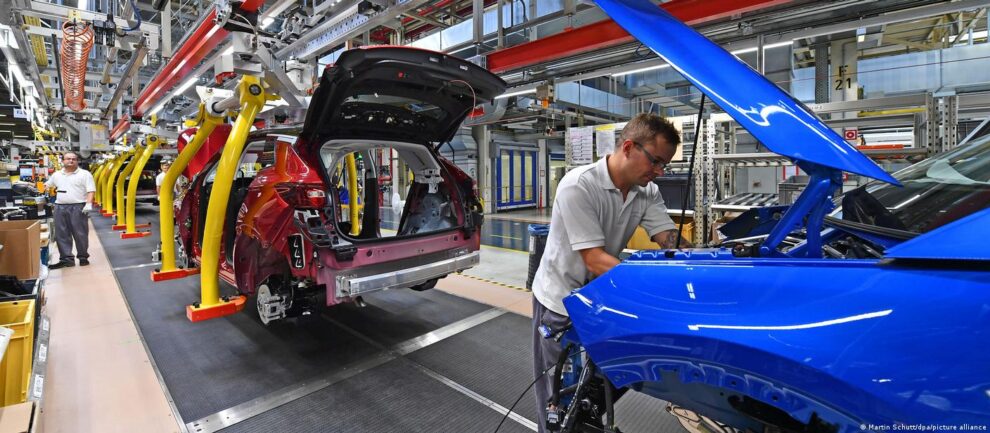Inflation has taken a heavy toll on the German economy, with consumers spending less on items such as food and clothing. To make matters worse, the outlook for the rest of the year isn’t looking much brighter.
Germany’s economy shrunk slightly in the first quarter of 2023 compared with the previous three months, thereby entering a technical recession, data showed on Thursday.
A preliminary estimate had shown gross domestic product (GPD) stagnating at zero growth in the first quarter — meaning Germany would have narrowly escaped a recession. But recession fears were spurred again after data published earlier this month showed that German industrial production fell more than expected in March, hurt by a weak performance by the key automotive sector.
“It took a couple of statistical revisions, but at the end of the day, the German economy actually did this winter what we had feared already since last summer,” ING economist Carsten Brzeski said in a note to clients. “The warm winter weather, a rebound in industrial activity, helped by the Chinese reopening and an easing of supply chain frictions were not enough to get the economy out of the recessionary danger zone.”
What did the data show?
GDP fell by 0.3% for the quarter when adjusted for price and seasonal effects, according to the data from the Federal Statistical Office, Destatis.
“After GDP growth entered negative territory at the end of 2022, the German economy has now recorded two consecutive negative quarters,” said Destatis President Ruth Brand.
The January to March figures follow a drop of 0.5% in the fourth quarter of 2022. A recession is commonly defined as two successive quarters of contraction.
Inflation continued to take its toll on the German economy during the quarter, the office said. This was reflected in household consumption, which was down 1.2% quarter-on-quarter after price and seasonal adjustments. Consumers have seen high inflation erode their purchasing power, reducing demand in the economy. Although the upward price trend has recently eased, the annual inflation rate of 7.2% recorded in April was still relatively high.
Private households spent less on food, drink, clothing, shoes and furniture than in the previous quarter. They also bought fewer new cars, possibly due to the discontinuation of government subsidies at the end of 2022. Government spending also slumped in the first three months of the year.
There was a ray of light when it came to investment, which was up in the first three months of the year after a weak second half of 2022, helped by a temporary rebound in the construction sector in unseasonably warm weather.
“The fall in GDP by 0.3% q/q [quarter-on-quarter] is much more in line with expectations at the beginning of the year as Germany has been hit by both high inflation and rising interest rates,” Andrew Kenningham, chief Europe economist at Capital Economics, told DW.
Germany avoids severe recession but outlook remains murky
Heavily reliant on Russian energy imports, Germany was left particularly exposed following the Russian invasion of Ukraine in February 2022.
A mild winter in Germany meant that the worst scenarios — such as a gas shortage, which would have ravaged the economy — did not occur.
Germany’s last recession came as the COVID-19 pandemic at the start of 2020 prompted governments to effectively shutter whole sectors of the economy.
The latest GDP figures are the latest in a series of data highlighting Germany’s economic troubles. The country’s crucial manufacturing sector is struggling amid weak demand for goods. A gauge of business climate published by the ifo Institute fell more than expected in May, marking the first decline after six consecutive increases.
The ifo Export Expectations fell to the lowest level since November 2022 with automotive companies severely curbing their export plans.
“The optimism at the start of the year seems to have given way to more of a sense of reality,” Brzeski said. “A drop in purchasing power, thinned-out industrial order books as well as the impact of the most aggressive monetary policy tightening in decades, and the expected slowdown of the US economy all argue in favor of weak economic activity.”
What does a German recession mean for the eurozone?
An economic contraction and bleak outlook in Europe’s biggest economy is bad news for the entire eurozone with the most obvious implication being a downward revision of the common currency area’s first-quarter GDP.
Kenningham expects eurozone GDP to be revised down to 0.0% in the first quarter from 0.1%, meaning that the bloc will avoid a technical recession by the slimmest of margins.
The eurozone is also reeling from high inflation and rising interest rates which are squeezing household consumption and business investment. The manufacturing sector is struggling with a sharp decline in new orders. The services sector, however, remains a bright spot as families hit by inflation prioritize spending on travel and leisure over buying goods.
The economic situation is expected to remain grim as the European Central Bank continues hiking interest rates to dampen demand in order to bring down prices. Inflation in the eurozone area, which came in at 7% in April, remains well above the central bank’s 2% target.
Source: dw















